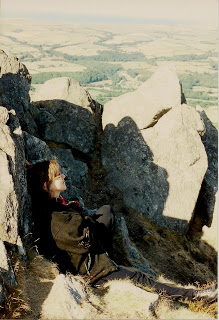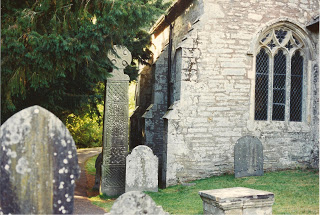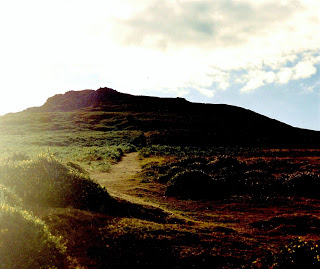An Inconvenient Faith — Part 2
Sometime after the experience I talked about in “An Inconvenient Faith 1”, back when my husband and I were still living in France, Ron asked me where I wanted to go on vacation, and I said Wales. I chose Wales because I am drawn to the craggy places of the world, the lonely moors, the rocky seacoasts, the barren and windswept spots. Not that all of Wales is like that, of course, but there are some lovely craggy bits.
While in Wales, we visited the Church St. Brynach, also known as the Church of the Bleeding Yew.
This is what I found on the web about St. Brynach:
The church of St. Brynach in the village is believed to stand on the site of the saint’s hermitage. While the current church building is of more recent construction, the antiquity of the site is indicated by the presence of a number of ancient inscribed stones in the churchyard and the church itself dating from the time of the saint. The Vortiper stone, which stands just outside the church entrance and has inscriptions in both Latin and Irish Ogham scripts, has been dated to c.466 to c.533; another dual-script stone has been re-used as a lintel inside the church, and at least one more Latin-inscribed stone can be seen on the outer fabric of the structure.
St. Brynach himself lived an austere life of constant fasting and prayer. Wild beasts became tame for the saint, and his holiness was so great that he communed with angels on the summit of nearby Carn Ingli, the Mountain of Angels (also the site of a pre-Christian hillfort), which dominates the local landscape. A twelfth century hagiography, the Vita Sancti Bernachius exists, written by an anonymous author in the district of Cemaes, which includes Nevern.
This is a view of the “Mountain of Angels”
The path leading up to the church is flanked by six ancient yew trees, one of which bleeds red sap every spring. No one, apparently, knows why, and as yet no arborist or botanist has been able to figure it out. Who knows? Doesn’t matter, really. The fact that the trees have been around for more than a 1,000 years is miracle enough for me.
Inside that simple old church, I sat in a pew in the Lady Chapel. The soft, milky light filtered in from the drizzling sky outside and everything grew quiet. I felt I was not alone.
“Oh, dear,” I thought.
I was then overwhelmed with a sense of sacred presence. I kid you not. The Big Presence.
The first thing I thought was, “Holy crap.”
The second thing I thought was, “Well, this is highly inconvenient.”
I was not, at the time, favourably disposed to Christianity.
Christianity, at that point, seemed to me like a lot of rather simple-minded people nattering away about why only the people who believe in Jesus (as they defined him) are going to heaven (which indicated God has far less understanding and compassion than even I do, for goodness sake), how Jesus is going to return in a big cloud and bodily scoop up all the good folk (meaning them, of course), and how the world was created in six days. You know, Adam and Eve on dinosaurs.
And that was how I thought about the least offensive Christians.
The worst were those church-protected pedophiles, the smug right-wing nuts who have invaded politics, who bomb women’s health clinics, who spit venom at the funerals of gay murder victims – you know, the modern versions of those responsible for the crusades, the Spanish (and other) Inquisitions, Anti-Semitism, and the genocide of First Nations and Aboriginal peoples.
So you can imagine how inconvenient I f
ound experiencing the sacred in a flippin’ church. A sacred spring? Sure. A sweatlodge? Absolutely? On a wind-swept mountain top? You bet. But here?? In an old church? Oh, good grief. And yet still, there is was. Undeniable. Prodding. Humbling. Highly inconvenient.
Let me be as clear as I can: I don’t think everyone needs a religious life. In fact, some of the most deeply spiritual and moral people I know, like my wonderful husband, are perfectly content not to attend religious services of any kind, not to formally pray or meditate and not to align themselves with any particular school of religious thought. My husband is like a lot of folks I admire — the sort of guy who stands looking out at the ocean, or at a field of wheat, or at the cedar tree in our back garden, feels filled with a Presence and knows that all is right with the world.
I’m not so lucky. I’m a fusser, an analyser and a nit-picker. Once, a dear friend told me that the only thing I needed to know about God was that I wasn’t it. True. And that pretty sums up my definition of God (a Great Mystery of which I am a part and which resides in me, but is greater than I am), but it doesn’t help me develop a greater relationship with Whatever It Is That Isn’t Me. At one time or another I’ve studied Baha’i, Judaism, Islam, Midewin (traditional Ojibway religion), Buddhism, Taoism, Hinduism, Wiccan, Quaker, Unitarian Universalist… I could go on, but you get the point. There was nothing about the core theology of any of the religions I’d studied I didn’t agree with, nothing I couldn’t intellectually find peace with.
Okay, I can hear some of my more traditionally-minded friends shrieking here – calling me a “Relativist” and praying for my soul. Thanks. I can use all the prayers I can get. But really, I don’t believe all things are equally valid. What I believe is that The Great Mystery, The Ineffable, The Creative Force, God, if you will, loves all of us equally and will use whatever set of symbols, whatever messenger will best reach us.
Joe Couture, an ex-Jesuit priest who returned to his Cree roots, once said that the Native American Thunderbird and the Archangel Michael are the same spirit. Precisely.
For some the language that speaks to them might even be science and the limitless mystery of infinity, which leaves the whole question of God out of it and is, I suspect, just fine with God if that’s what works for you.
Still, after decades of searching, my horizons were so broad they stretched out in a meaningless waste in all directions: covered a lot of ground, none of is deeply. Intellectually, I was satisfied (possibly even self-satisfied), but something was missing. I’ve always believed in a power greater than myself, but for a long time I had the niggling sense that there was something just outside my line of vision that I couldn’t quite pull into focus.
Many of my dear friends shun religion because they have awful associations with the symbols of those religions. You know who you are, you call yourself Born Again Pagans (which is a religion, too, after all), or Recovering Catholics, or Scientists! (there’s a good article by P.J. O’Rourke on faith and science here.) I’m no different that anyone else. Symbols can really hang me up. Less now, but back at the time I’m writing about, I had a few, ahem, issues.
Still, I always maintained that although God does not require of us that we each follow the precisely same path to His/Her door; God does offer us an invitation to respond to that which resonates in us. And I’ve always suspected God could be pretty persistent about the invitation.
So, there I was. In a church. For the second time. Resonating like a ten-ton church bell. If I truly believed that no religion was ‘better’ than another, that all such symbolic language was used by a loving God to try and reach us, then why was I so resistant to investigating the symbols of Christianity?
Indeed. Could the problem rest not with the symbolic language of Christianity, but with me and my prejudices? Open-minded ME? Yuck.
It seemed I was going to have to find out…
Copyright 2008 Lauren B. Davis For permissions: laurenbdavis.iCopyright.com


